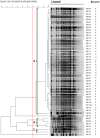The impact of inadequate terminal disinfection on an outbreak of imipenem-resistant Acinetobacter baumannii in an intensive care unit
- PMID: 25255439
- PMCID: PMC4177873
- DOI: 10.1371/journal.pone.0107975
The impact of inadequate terminal disinfection on an outbreak of imipenem-resistant Acinetobacter baumannii in an intensive care unit
Abstract
Background: This study was conducted to investigate an outbreak caused by imipenem-resistant Acinetobacter baumannii (IRAB) in a medical intensive care unit (ICU) in a regional hospital.
Methods: In response to an IRAB outbreak from October 2012 to February 2013, we developed several infection control measures, including an extensive review process of environmental cleaning and disinfection, and used molecular methods to identify each clinical and environmental IRAB isolate.
Results: During this five-month period, 22 patients were colonized with IRAB and 18 patients had IRAB infections. The in-hospital mortality rate was significantly higher among patients with infections rather than colonizations (44.4% vs 9.1%, p = 0.028). Additionally, nine environmental specimens, including five specimens collected after terminal disinfection, were positive for IRAB. 12 environmental isolates and 28 of 36 available clinical isolates belonged to one unique pulsotype A, which was confirmed by molecular methods. We found the concentration of disinfectant, 0.08% sodium hypochlorite, was inadequate. After correcting the environmental cleansing methods, the surveillance study showed no further IRAB isolates on the control panel surfaces of the medical equipment or in patients in the ICU. Additionally, an in vitro study of IRAB immersed in different concentrations of sodium hypochlorite showed that 0.5% sodium hypochlorite eradicates IRAB after 30 seconds of inoculation, but 0.08% sodium hypochlorite only reduces the bacterial load.
Conclusions: This study highlights the importance of the preparation of disinfectants to adequately achieve environmental disinfection in the control of IRAB outbreaks in the ICU.
Conflict of interest statement
Figures



References
-
- Maragakis L, Perl TM (2008) Acinetobacter baumannii: epidemiology, antimicrobial resistance, and treatment options. Clin Infect Dis 46: 1254–1263. - PubMed
-
- Playford EG, Craig JC, Iredell JR (2007) Carbapenem-resistant Acinetobacter baumannii in intensive care unit patients: risk factors for acquisition, infection and their consequences. J Hosp Infect 65: 204–211. - PubMed
-
- García-Garmendia JL, Ortiz-Leyba C, Garnacho-Montero J, Jiménez-Jiménez FJ, Pérez-Paredes C, et al. (2001) Risk factors for Acinetobacter baumannii nosocomial bacteremia in critical ill patients: a cohort study. Clin Infect Dis 33: 939–946. - PubMed
-
- Horan TC, Andrus M, Dudeck MA (2008) CDC/NHSN surveillance definition of healthcare-associated infection and criteria for specific types of infections in the acute care setting. Am J Infect Control 36: 309–332. - PubMed
MeSH terms
Substances
LinkOut - more resources
Full Text Sources
Other Literature Sources
Medical

